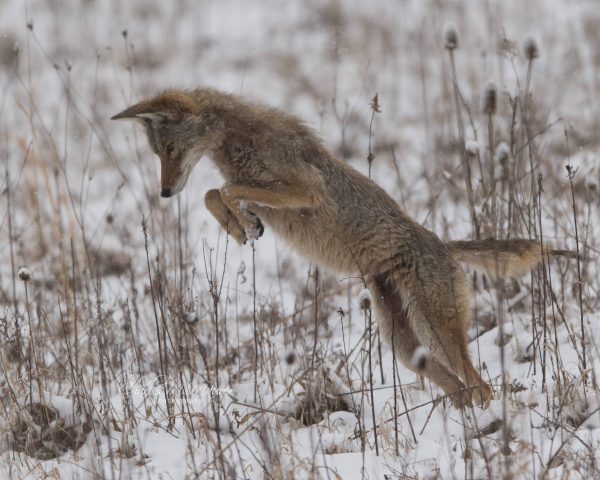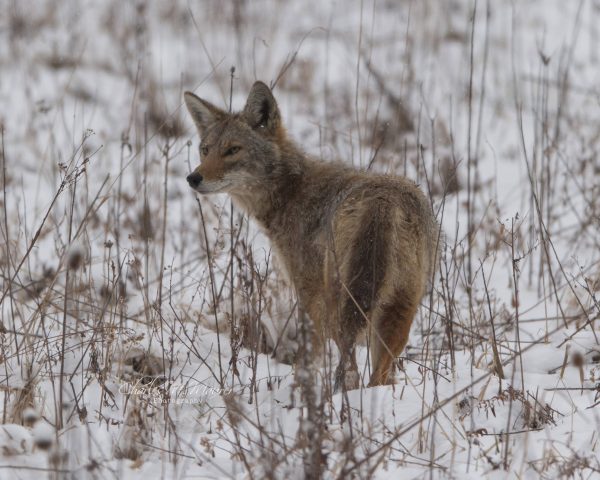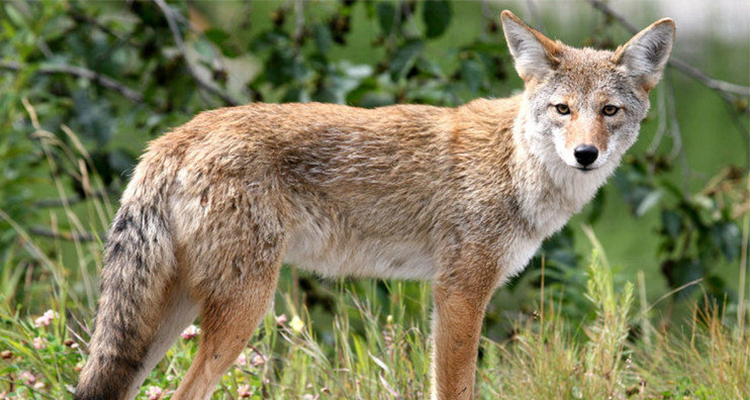“Ithought it was our neighbor’s dog on the loose.”
“They are brave. Some nights when they are tracking/killing it is so loud.”
“Bethlehem is loaded with them. We got a Great Pyrenees to keep them away.”
These are some of the responses I got on social media when I asked about coyotes. Many people have a story. But where did the coyotes come from, and what does their presence mean for us in the Ohio Valley? People say their numbers are on the rise, and the deer are vanishing. Some fear for pets, livestock and small children.
Should we?
THE ARRIVAL OF THE COYOTE
The dominant predators in the east used to be the timber wolf (also known as the gray wolf) and the mountain lion. Wolves once covered the entire eastern United States. However, in the early part of the 20th century, all predators were considered bad, and we did our best to eliminate them. Human activity — both hunting and the destruction of wolf habitat — led to the species’ near extinction in the early 1900s.
Today, the endangered eastern timber wolf exists in only 3 percent of its original habitat, while the eastern cougar has been declared extinct.*
Once these large predators were gone, white-tailed deer had nothing to keep their population in check. In addition, habitat changes (e.g., forests becoming farmland) left the door open for a new predator. One hundred years ago, the western coyote began to move east, and as it did, it bred with the remaining wolves in the Great Lakes region. The resulting eastern coyote, which first settled in Canada, is noticeably larger than its western counterpart and has a wider territory.
The animals moved south, and the first coyote was sighted in West Virginia in 1975. Since then, coyotes have established themselves all over the east thanks to their remarkable versatility. A coyote is an omnivore; they eat everything from rabbits, mice and insects to fruit, vegetables and garbage. They can also thrive almost anywhere, making them one of the most adaptable animals on the planet. Night cameras catch them trotting around urban neighborhoods. They’ve been found in New York’s Central Park and downtown Chicago.
COYOTES AND THE DEER POPULATION
Hunters have been reporting that the white-tailed deer population is in decline. It is, according to DNR wildlife biologist Rich Rogers. He’s conducted both deer research and coyote research with WVU. He’s a “fur-bearer biologist” and the person to call if you have a West Virginia mammal question.
Coyotes, bobcats and bears are major predators of fawns. In June and July, a coyote’s diet consists of 70 percent fawns. But they aren’t the reason hunters have noted a decline.

“A lot of people think coyotes are killing all the deer. That’s just not true,” Rogers said. “Deer densities have been declining now for a number of years, mainly due to high antlerless harvests, which is what we wanted. We wanted to get these deer densities down close to the carrying capacity. They were way over for a number of years.” He also explained that there’s not as much timber-cutting as there used to be, and deer rely on brushy land and trees in early stages of development for food.
When we note the declining deer population (or a missing cat), and then see or hear a family of coyotes in the area, we automatically connect the two. It’s called confirmation bias. But correlation does not equal causation.
“People find evidence for things, preconceived ideas, only instead of trying to disprove a hypothesis, they try to prove it,” Rogers said. “And … what happens is people see something and then, anecdotally, they think that’s … data, and it’s not right.”
A recent Pennsylvania study looked at fawn mortality. While fawns die from predation (black bears kill more than coyotes), it doesn’t reduce the deer population. To be certain, biologists repeated the study and got the same results. A 2018 University of Delaware study was also done on fawn mortality. Coyotes, bears and bobcats do not exist in Delaware, but the rate of fawn deaths was the same as West Virginia’s and Pennsylvania’s.
“Everything kills fawns,” Rogers said, adding that he’s even seen a mink kill a fawn. Starvation is very common, too.
Coyotes have an undeserved reputation as killers, an image that was not helped by a recent PBS documentary called Meet the Coywolf.
“That was pure, unadulterated garbage,” Rogers said. “And that caused such a stir, that program, with people thinking, ‘Oh my gosh, we’ve got this elite predator on the loose?’ That’s not true. Absolutely not true. Coyotes aren’t elite predators.”
He said there are not as many coyotes in the Ohio Valley as we think there are. In fact, the number living in Marshall, Ohio, Brooke and Hancock counties combined is only around 260 animals.
The intensity of the nightly coyote chorus makes that figure hard to believe, but Rogers said those yips and screams come from only four or five animals. Coyotes don’t live in packs; it’s a family group consisting of two monogamous parents and their young, and their chances of survival are poor.
“Half the coyotes die every year,” Rogers said. Most never make it to age 4.
He’s also heard the rumor that the DNR introduced coyotes to control the deer population.
“That is a provincial myth,” he said. “No state has ever introduced coyotes. Over the past 34 years, I have had many people tell me that they have proof of such, and I have yet to be provided with any. I can confidently say the same of all my colleagues in every northeast and southeast state.”
BUT THEY EAT CATS
In January 2019, the Village of Bethlehem posted on social media that residents should keep their pets indoors, as coyotes had been spotted. I called the police department, and they’ve received no reports of actual pet deaths. But walkers are advised to keep dogs on a leash and avoid brushy areas where coyotes might den. And if you’re noticing fewer rabbits and small rodents on your property, coyotes may be responsible — it’s what they eat.
Coyotes are shy creatures that avoid humans. But there are problem coyotes — the ones that kill cats, dogs and livestock — and they’re often transient animals that have just struck out on their own.

The Wildlife Services section of the U.S. Department of Agriculture addresses livestock killings, not by eliminating all coyotes, but by eliminating problem coyotes. These are the ones that snatch lambs and, in the past, caused problems for sheep and goat farmers. The industry was on a decline in West Virginia until this elimination program began around the year 2000. Since then, the trend has reversed.
When it comes to coyote population control, the DNR does not kill indiscriminately.
“Bounty studies have shown in the past that [hunts] do not work,” Rogers said. “You have to kill an extraordinary number of coyotes every year in order to deplete the population to have any kind of an impact.”
Coyotes are naturally afraid of humans and do not view humans as a food source. They are not a threat to hikers. They will not come out of the forest in a pack and attack you.
However, if a coyote learns to associate people with food, then the animal becomes a problem. Store garbage properly and keep pet food indoors — these are easy meals for a coyote. Wildlife officials also recommend keeping cats and dogs indoors and supervising pets when they’re outside.
“They’ll eat your housecats if you don’t watch them,” Rogers said.
A problem coyote should be reported to the Division of Natural Resources. They can be hunted year-round in West Virginia; check regulations for details.
GOING NOWHERE
We have good reason to protect our pets and to avoid coyotes, as our interactions with them will only encourage more interactions. We also have reason to talk with the scientists who study these animals — they welcome the conversation.**
While it’s important to keep an eye on the coyote population, it’s also important to understand the role predators play in our ecosystem. Nature does her best to create a balance, and when humans upset it, there are always consequences.
Perhaps most of all, we need to remember that the coyote was made for survival. Anywhere we can thrive, the coyote probably will, too. It’s just as adaptable as we are, and it’s here to stay.
* Several people have told me over the years that they’ve seen eastern cougar tracks. However, the species was officially classified as extinct by the U.S. Fish and Wildlife Service in 2018. FWS acknowledges that the occasional animal exists, but they are believed to be wanderers from western territory or an escaped captive animal. Nevertheless, there’s continued controversy about their presence.
** Rogers reminded me that “everything [the DNR does] is open to public scrutiny by law. We cannot undertake any projects in secrecy.”
Coyote photos by Chuck Maurer.
• Laura Jackson Roberts is a freelance writer in Wheeling, W.Va. She holds an MFA in Creative Writing from Chatham University and writes about nature and the environment. Her work has recently appeared in Brain, Child Magazine, Vandaleer, Animal, Matador Network, Defenestration, The Higgs Weldon and the Erma Bombeck humor site. Laura is the Northern Panhandle representative for West Virginia Writers, a blog editor for Literary Mama Magazine and a member of Ohio Valley Writers. She recently finished her first book of humor. Laura lives in Wheeling with her husband and their sons. Visit her online at www.laurajacksonroberts.com.


